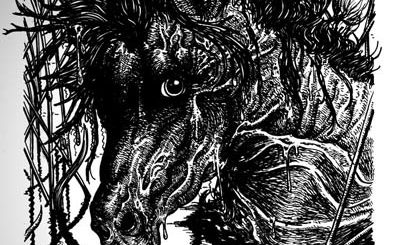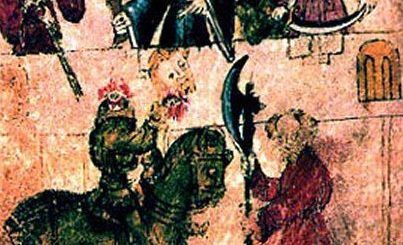The Origin of The Wrekin
This is one of two folktales, which explain the origin of the Wrekin, a 1,334 foot high hill standing on the Shropshire plain. The hill has the remains of an Iron Age Hillfort on its summit, and folk evidence suggests it was an important focal point for our prehistoric ancestors. This tale appears in Shropshire Folk-Lore: A Sheaf of Gleanings by C. S. Burne and G. F Jackson, London 1883.
Once upon a time there was a wicked old giant in Wales, who, for some reason or other had a very great spite against the Mayor of Shrewsbury and all his people, and made up his mind to dam the Severn, and by that means cause such a flood that the town would be drowned.
 So off he set, carrying a spade full of earth, and tramped along mile after mile trying to find the way to Shrewsbury. And how he missed it I can not tell, but he must have gone wrong somewhere, for at last he got close to Wellington, and by that time he was puffing and blowing under his heavy load, and wishing he was at the end of his journey.
So off he set, carrying a spade full of earth, and tramped along mile after mile trying to find the way to Shrewsbury. And how he missed it I can not tell, but he must have gone wrong somewhere, for at last he got close to Wellington, and by that time he was puffing and blowing under his heavy load, and wishing he was at the end of his journey.
By and by there came a cobbler along the road with a sack of old boots and shoes on his back, for he lived at Wellington, and went once a fortnight to Shrewsbury to collect his customers’ old boots and shoes, and take them home with him to mend. And the giant called out to him. “I say” he said, “how far is it to Shrewsbury?” “Shrewsbury?” said the cobbler. “What do you want at Shrewsbury?” “Why” said the giant, “to fill up the Severn with this lump of earth I’ve got here. I’ve an old grudge against the mayor and the folks at Shrewsbury, and now I mean to drown them and get rid of them all at once.” “My word” thought the cobbler. “This will never do! I can’t afford to lose my customers!” and he spoke up again. “Eh!” he said. “You’ll never get to Shrewsbury, not today nor tomorrow.
Why look at me! I’m just come from Shrewsbury, and I’ve had time to wear out all these old boots and shoes on the road since I started.” And he showed him his sack. “Oh!” said the giant with a great groan. “Then it’s no use! I’m fairly tired out already, and I can’t carry this load of mine any farther. I shall just drop it here and go back home.”
So he dropped the earth on the ground just where he stood, and scraped his boots on the spade, and off he went home again to Wales, and nobody heard anything of him in Shropshire after. But where he put down his load there stands the Wrekin to this day, and even the earth he scraped off his boots was such a pile that it made the little Ercall by the Wrekin‘s side.
This is the second tale about the origin of the Wrekin. This tale tells how two giants created the Wrekin, and also explains the origin of some of its geological features. The story first appeared in Shropshire Folk-Lore: A Sheaf of Gleanings by C. S. Burne and G. F Jackson, London 1883.
Long, long ago, when there were giants in the land, two of them were turned out by the rest, and forced to go and live by themselves, so they set to work to build themselves a hill to live in. In a very short time they had dug out the earth from the bed of the Severn, which runs in the trench they made to the present time, and with it they piled up the Wrekin, intending to make it their home.
Those bare patches on the turf between the Bladderstone and the top of the hill, are the marks of their feet, where from that day to this the grass has never grown.
But they had not been there long before they quarrelled, and one of them struck at the other with his spade, but failed to hit him, and the spade descending to the ground cleft the solid rock and left the ‘Needle’s Eye’. Then they began to fight and the giant with the spade (for they seem to have had only one between them – perhaps that was what they quarrelled about!) was getting the best of it at first, but a Raven flew up and pecked at his eyes, and the pain made him shed such a mighty tear that it hollowed out the little basin in the rock which we call the Raven’s Bowl, or sometimes the Cuckoo’s Cup, which has never been dry since, but is always full of water even in the hottest summer.
And now you suppose that it was very easy for the other giant to master the one who had the spade, and when he had done so he determined to put him where he could never trouble anyone again. So he very quickly built up the Ercall Hill beside the Wrekin, and imprisoned his fallen foe within it. There the poor blind giant remains to this day, and in the dead of night you may sometimes hear him groaning.























Recent Comments